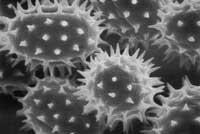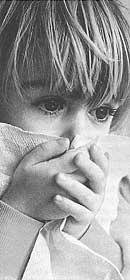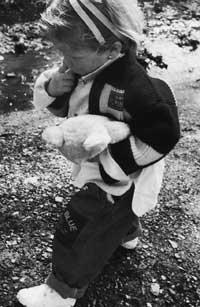Allergies in children
Among us, fifteen out of every hundred children suffer some kind of allergy.
What are the most common allergies in children?
Respirators.
Up to 3 years mites (powders, e.g.) and fungi. From 3 years, ploron or pollen.

The most frequent symptoms are the nasal ones, since this part is in contact with the outside and is the first that is irritated. Before the external “enemy” the nose closes and does not fulfill its function of filtering, heating and moistening the air. The symptoms are usinas or sneezing, flow, surprises and the big spicy.
When the nose is blocked, the child breathes through the mouth and the air does not get properly (clean, hot and dry) to the airways. Then other reactions are put in place: cough when compressing the trachea or trachea, hot in the bronchi and breathing (asthma) alveolar, the worst symptom of respiratory allergy.
The eyes are also irritated to allergens: reddened eyes, watery eyes, swollen eyelids and itching.
And do children have digestive allergies?
Milk, egg, fish, nuts, cereals and legumes are foods that can produce allergies to the digestive system (by this order of preference). Many of these foods are seeds and have a high content of enzymes (highly allergenic substances). Symptoms are usually edema of the tongue and lips, diarrhea, vomiting, and discomfort.
And what are the symptoms of skin allergies?
- Urticarias. At one time or another in childhood, 18% of children have spots on the skin, in relief, which appear abruptly (creating a great zeal) and which usually do not last more than 24 hours. This type of reaction may be due to infections (respiratory, urinary or liserials) and contact with plants and animals (dogs or cats). In some cases they are due to irritating substances and to a lesser extent to antibiotics. Foods, although people believe it differently, rarely produce urticaria.
- There are also atopic dermatitis, such as eczema in body folds (arm/arm junction, knees and sometimes neck). In this case, the main producers are food (mainly eggs and nuts), followed by drugs (sulfamides, penicillin, analgesics).
And about allergy to pollen or lorautsa, what?

It usually needs between two and three years to sensitize children and in most cases the allergy appears between the fourth and sixth year.
When the child has symptoms of cataract, conjunctivitis, or asthma, and has no fever and there are no other family members or sick parents in their environment, it can be thought to be an allergy. If there are also other allergies in the family (grandparents, parents, etc.) Our suspicions will be confirmed. And then you should go to the doctor as soon as possible.
When we have an allergy at home there are many things to change. In these houses the ventilation or ventilation will be done in the early hours of the morning, with the wind still calm to prevent the pollen from entering the interior of the house. It is convenient to keep the windows closed for the rest of hours.
Once checked by the specialist that it is an allergy to flowering, it is advisable to place humidifier, but only then. If the allergy were to mites (domestic dust) or fungi, this measure could cause more damage than benefits. It is recommended to install the child's bedroom in a sunny place (if possible), with the minimum possible furniture. And all carpets, plush toys, etc. That they can retain or accumulate dust will come outside.
In addition, there are a number of measures to be taken in the child's hygiene: the nostrils will be cleaned frequently (since they are the main entrance door of the allergen) and a lot of water will be given, since when diuresis increases, the proteins of pollen that are in the blood are removed. And the humidity, for its part, facilitates the work of the silos of the bronchi, which are responsible for expelling to the outside the parrot that has reached the inferior airways.
Clean your eyes well (serum with saline) and protect them properly from light (sunglasses).
When going out to the street, when the plants are in the time of pollination (and the “risk”, so it is usually from March to June to July, being the worst time in early May), the allergen must prevent the child from taking excessively strict measures. It is advisable to be careful when it is very windy, since the highest concentrations of flowering are concentrated in the air. And those days the child, if he can, should not leave home. If you have to go to school or nursery, better in the car and with the windows closed.
If any parent is allergic, are children also?

Allergy is known to have some hereditary component. And the numbers show that both parents are allergic, they have allergic children in 84% of cases. If the allergic is a single parent, the possibility that children are also allergic decreases to 41%. But allergy can also appear without a family history. This happens in 16% of children.
A number of factors have been mentioned that would facilitate the spontaneous appearance of allergy: fetal suffering during childbirth, smoke contamination at home (by the action of smokers) or certain childhood infections (measles, cough, etc. ). ).
What can be done to prevent this disease?
In cases of family history, parents may take steps to delay the onset of allergy:
- The mother should not smoke during pregnancy.
- That childbirth is as natural as possible so that the fetus does not suffer (importance of the gynecologist)
- Avoid domestic pollution, especially smoke.
- Breastfeed the child for as long as possible. Breast milk has several topics (macrophages, lymphocytes, etc. ). ), to protect the child. Cow's milk does not contain these defensive elements and also contains a very allergenic protein.
- To be able to be and looking home, do not live on the last floor. Neither on the ground or first floor, which are the most humid and where the mites and fungi grow best. If the house is sunny, better, because the sun kills mites and fungi.
- The child's room should be new, clean, and with the least number of things to avoid dust accumulation.
- Since the cold facilitates allergy, the child should not drink food drinks or sweet food too cold. Take ice cream or frozen laminated, not bites.
Is this allergy treated?
First of all, a diagnosis must be made: to evaluate family members in advance, to see the story of the child, etc. Taking into account the age of the child (which if small does not serve), the specialist will do skin tests.
Later, when the allergen is well identified, it can proceed to immunotherapy, that is to say, to inject in increasing doses the substance that produces or produces allergy to the child (lorauta, mites, bacteria, fungi, ...) until reaching the maximum amount that tolerates. This dose should then be kept for two years after the allergic symptoms disappear.
Immunotherapy is performed before the time of the year of onset of the disease or throughout the year with breaks. There is no vaccine for food allergies.

The vaccine must be individualized, that is, made specifically for each patient. When it is a vaccine made by a specialist and applied correctly, between 85 and 92% of children will have no signs of allergy. However, other vaccines do not have such good consequences.
Immunotherapy should begin as soon as possible, since the child, not being so sensitized, accepts more hyposensitizing extracts. The later it begins, the worse the vaccine is tolerated, and the process will be longer. Antibacterial immunotherapy can begin from 12 months, the vaccine against mites and fungi from 2-3 years and the anti-pollen at 3-4 years.
Do allergies need psychological help?
According to a study, asthmatic children have more psychological problems than diabetics. The allergic crises of children provoke a great anxiety or anxiety to their mothers and the child realizes it and she also suffers that anguish. This is, therefore, a problem that must be taken into account so that the child is not “protected” too much and that he or she makes the same life as the rest of the children.
Has the number of allergies increased in recent years?
On the one hand, today allergies are better known and diagnosed better, which can result in a greater number of allergic children. On the other hand, some social factors facilitate the appearance of allergies, such as stress, which is also observed in children, or current diet
Another factor is congestion. This increases respiratory infections, which destroy the respiratory mucosa, making them more painful before allergens.
Buletina
Bidali zure helbide elektronikoa eta jaso asteroko buletina zure sarrera-ontzian











